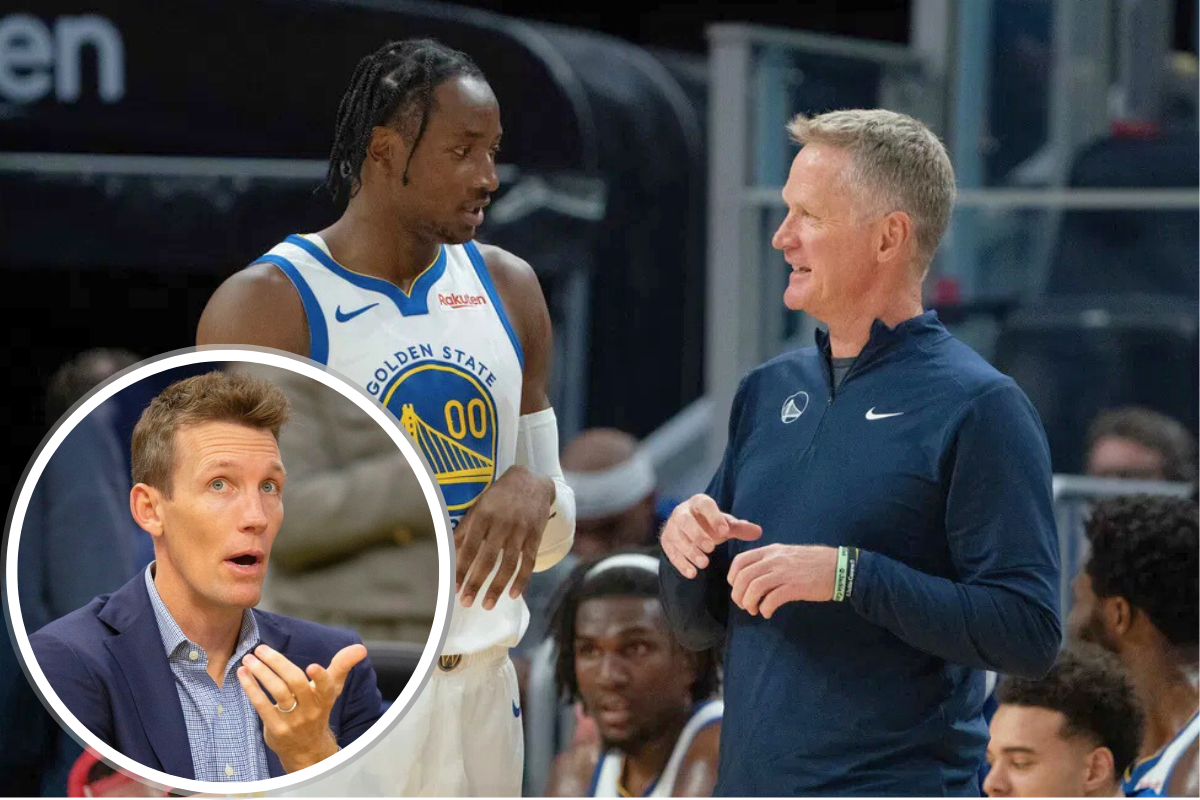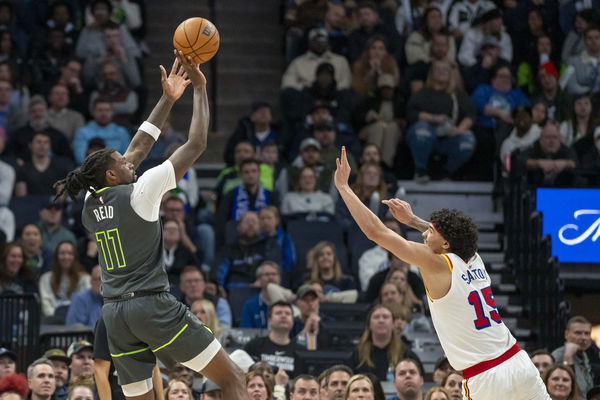
Imago
Image Credits: IMAGN

Imago
Image Credits: IMAGN
When Stephen Curry went down with a hamstring injury in the playoffs, Jonathan Kuminga finally got his runway. The 22-year-old forward averaged 24.3 points over four games against Minnesota, showing the kind of on-ball explosiveness that once made him a cornerstone of the Warriors’ post-dynasty plans. But Golden State lost all four. And Steve Kerr, watching his team fall apart without its superstar, didn’t exactly see a vision of the future in Kuminga’s solo act. And by extension, it seems there are two other names also on the chopping board. But back to JK first.
Watch What’s Trending Now!
“Right now, he’s not a guy who I can say I’m going to play 38 minutes—with the roster that we have—and expect to win,” Kerr said on The TK Show late May. “All I do is try to win. That doesn’t necessarily mean everybody’s going to be happy.” Steve’s words, while not a sendoff, pulled no punches. And they landed just as Kuminga is set to enter restricted free agency, placing Golden State’s brass at a difficult—and potentially defining—offseason crossroads.
The 9x champion’s diagnosis, though, is much about the system as much as it is about skill. Coach Kerr also mentioned to Tim Kawakami in his pod that “he [Kuminga] is a ball-dominant player, 92nd percentile in usage rate this year in the NBA,” a reflection of his comfort with the ball in his hands. The challenge, though, is that in a team featuring Stephen Curry, Draymond Green, and Jimmy Butler, that type of role simply doesn’t exist. “And so the fit is tricky, there’s no question,” Steve promptly noted. And it is a brutal paradox.
ADVERTISEMENT
The Dubs need Kuminga to be a better complementary piece—more Shawn Marion or Aaron Gordon—but to evolve into that, the Congolese forward may need reps he can’t get in Golden State. As if this stylistic friction weren’t enough, the financial reality makes it even tougher. With over $139.6 million committed to just three players—Curry, Butler, and Green—the Warriors are already pushing up against the first salary cap apron. And adding Jonathan Kuminga’s expected market value deal could push them deeper into luxury tax. Not to mention, restrict future roster-building options under the new CBA.
As such, GM Mike Dunleavy didn’t sugarcoat things. “We have the ability to bring him back; he’s restricted, and you know, I think there’ll be good dialogue, and I’d like to figure something out sooner than later. That’d be great.” That would definitely be great, because the Warriors do have an identity crisis to sort out, too. If you remember, after surviving a 7-game war against Houston, the GSW collapsed against the Wolves. Why? Anthony Edwards & Co. diced up the Dubs’ shaky perimeter defense and exposed a roster lacking both rim protection and reliable point-of-attack defenders.

Imago
Jan 15, 2025; Minneapolis, Minnesota, USA; Minnesota Timberwolves center Naz Reid (11) shoots the ball over Golden State Warriors forward Gui Santos (15) in the second half at Target Center. Mandatory Credit: Jesse Johnson-Imagn Images
“I feel like that’s a big debate throughout the league right now,” the Warriors GM said, noting that the modern WC is loaded with explosive guards and high-efficiency paint scorers. “Generally, the rim protection is more valuable. At least that’s the way guys are paid, and guys are sought-after in trades. But if you ask any coach, point of attack is pretty important. Being able to control the ball handling and these pick-and-rolls.”
ADVERTISEMENT
Just this truth alone shows that the Warriors aren’t just behind the Thunder or Wolves; they’re behind the times. OKC has Chet Holmgren and Isaiah Hartenstein anchoring the paint. Minnesota leans on Rudy Gobert. Houston trots out Alperen Şengun and Steven Adams. Golden State has Trayce Jackson-Davis and an aging Draymond Green. And that’s why Kuminga’s market matters. And also why Dunleavy suggested it was “a main priority” to get the JK situation sorted. But for that, he will need his coach’s help.
ADVERTISEMENT
“I talk with the players. Steve does sometimes. He connects with, you know, our players on our roster, too. I mean, you have all these conversations in JK’s position, being an incumbent player. It’s a little bit more known, but yeah, I think some of those conversations will need to happen,” Dunleavy said in the media session.
In the meantime, there are two other players who can be up for trade as well—Moses Moody and Brandin Podziemski.
ADVERTISEMENT
Jonathan Kuminga’s future to be set away from the Dub Nation?
Due to injuries, there were questions about their return, but the GM provided a clear timeline while talking to the media. “Yeah, on the health front there, for sure those guys had successful procedures, and you know nothing major, which is good. And they’ll be able to get back and definitely be ready by training camp.” And yet, despite making a successful recovery from injury, their future in the Golden State is not secured.
Previously, the GM was very adamant about keeping his young core intact. They reportedly missed out on Paul George and Lauri Markkanen. But that was last season, and now Dunleavy is very much on board with parting ways with Jonathan Kuminga, Moses Moody, and Brandin Podziemski. Just a few days ago, veteran reporter Pasha Mardan shared the thought process of the Warriors franchise for trading two of those young stars.
“The Golden State Warriors have internally discussed packaging Moses Moody in Sign & Trade scenarios with Jonathan Kuminga.” Since Moody is set to begin the first year of his three-year $37.5 million deal next season, this decision from Dunleavy would be perfect to club in a trade package to acquire a bigger star. Similarly, Podziemski’s contract—$3.7M next season and a $5.7M option for 2026-27—makes him an attractive piece for win-now teams. And Kuminga’s market?
ADVERTISEMENT

Imago
Oct 30, 2024; San Francisco, California, USA; Golden State Warriors forward Jonathan Kuminga (00) huddles with guard Brandin Podziemski (2) during the game against New Orleans Pelicans during the fourth quarter at Chase Center. Mandatory Credit: David Gonzales-Imagn Images
With Kevin Durant traded to Houston, teams who missed out are looking elsewhere. The Brooklyn Nets, flush with cap space, are reportedly interested. The Chicago Bulls, long admirers of Kuminga’s elite athleticism, are another logical fit. In the midst of all this, the interesting aspect is that even the majority owner has handed the reins to the GM, especially when it comes to dealing with the future of Jonathan Kuminga: “But again, we have to look at what makes our team best, and that’s really up to Mike (Dunleavy) to make those decisions and to recommend to ownership what to do.” While nothing is imminent, the messaging from ownership is clear: Dunleavy has full authority to make hard decisions.
Free agency doesn’t officially open until July 6, but teams can begin negotiations on June 30 at 6:00 p.m. ET. For the Golden State, the outcome of the Kuminga saga may dictate everything that follows. As Tim Kawakami noted in The San Francisco Standard, “The Warriors just don’t have many ways to add to their roster other than seeing what they can get for Kuminga.” They thought he’d be a star by now. He might still be. Just maybe not in Golden State.
ADVERTISEMENT
ADVERTISEMENT
ADVERTISEMENT

